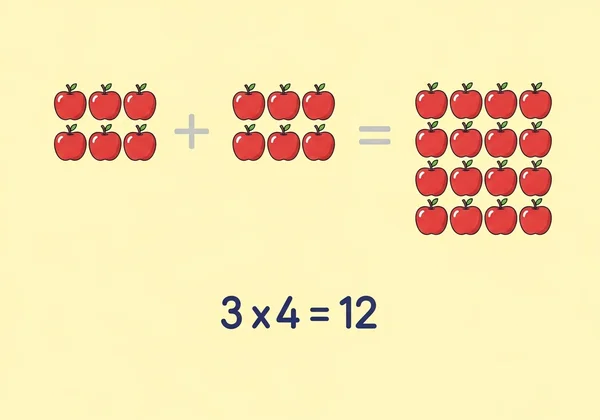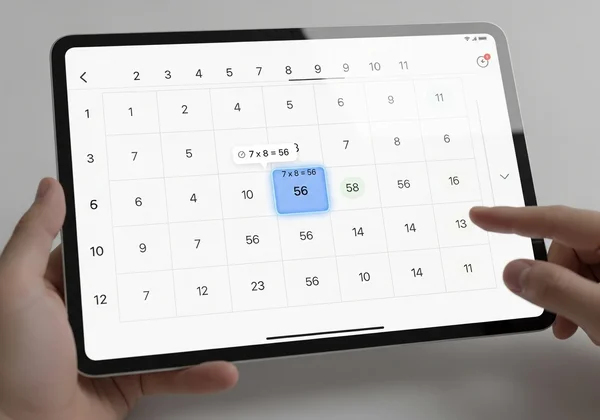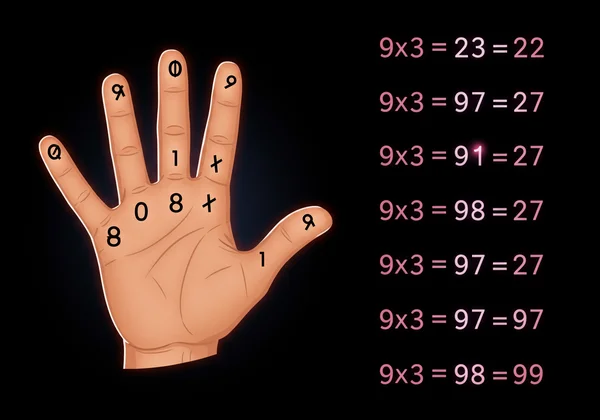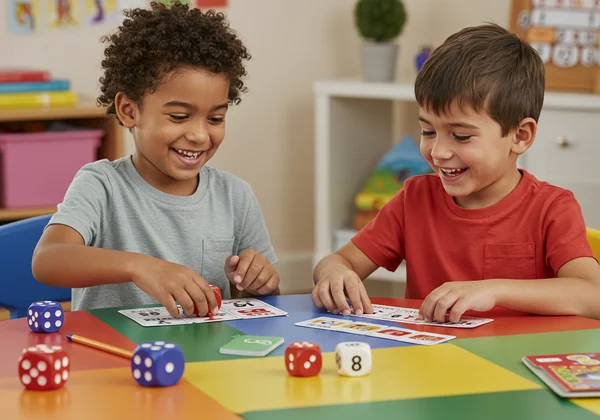Master the Multiplication Chart: Your Ultimate Times Table Guide (1-12)
Learning the times tables can feel like a huge challenge for students, parents, and teachers alike. But what if you had a clear path to follow? What are the easiest ways to learn multiplication? This guide will help you navigate each multiplication table from 1 to 12, offering simple strategies, clever tricks, and pattern discoveries to make learning feel achievable and even fun.
Learning multiplication isn't just about getting good grades; it's about building strong math muscles that'll help you tackle harder problems with ease. Whether you're just starting out or looking for better ways to teach, you're in the right place. Let's turn multiplication from a struggle into a success story, starting with powerful tools like our free interactive learning chart.
Why Mastering Multiplication Facts Matters So Much
So, why is it so important to master these facts? Memorizing the multiplication table isn't just about passing tests; it's about building a solid foundation for future learning and everyday life. Quick and accurate recall of multiplication facts frees up your brain to focus on more complex problems, from long division and fractions to algebra and beyond.
Building Confidence in Math and Beyond
There's a special kind of confidence that comes from knowing you have the right answers. When a child masters their times tables, they feel a sense of accomplishment that fuels their self-esteem. This confidence often extends beyond the math classroom, encouraging them to take on new challenges with a positive mindset. It proves that with practice and the right strategies, they can conquer difficult subjects.
Everyday Relevance: Multiplication in Real Life
"When will I ever use this?" It's a fair question, and multiplication has a clear answer. You use it when you're calculating the cost of multiple items at the grocery store, figuring out ingredients for a recipe you want to double, or planning supplies for a party. From budgeting to understanding sports statistics, multiplication is a practical life skill that makes daily tasks quicker and easier.
Foundational Strategies for Learning Times Tables Effectively
Mastery begins with a strong foundation. Instead of just memorizing, using smart strategies can make the learning process more intuitive and effective. These methods help connect abstract numbers to real concepts, making them stick.
Understanding the Basics: What is Multiplication?
Think of multiplication as a super-fast way of doing repeated addition. For example, 3 x 4 is the same as adding 4 three times (4 + 4 + 4 = 12). Grasping this simple idea helps demystify the process and gives you a backup plan if a specific fact is forgotten. It’s the first step from counting to calculating.

Visual Learning with Interactive Multiplication Charts
Visual tools can make a huge difference. When learners can see the numbers, the connections often click into place. A standard times table chart is a powerful tool, but an interactive one is a game-changer. Our interactive multiplication table allows you to hover over any cell and instantly see the corresponding numbers and the final answer. This immediate feedback helps create strong visual connections. You can also use our unique color-coding feature to highlight patterns, making facts easier to remember.

The Power of Repetition and Spaced Learning
Consistent practice is key, and a smart approach helps those facts stick for good. Spaced repetition involves reviewing multiplication facts at increasing intervals—for instance, right after learning, then an hour later, then the next day. This technique is proven to move information from short-term to long-term memory. You can use a printable multiplication chart to practice anytime, anywhere, reinforcing what you've learned online.
Unlocking Each Times Table: Smart Tips & Tricks for 1-12
Now, let's break down the times tables group by group. You'll find that with a few simple tricks, even the most intimidating numbers become manageable.
The "Easy" Ones: 0s, 1s, 10s, and 11s Tables
These tables follow simple, predictable rules that are easy to grasp.
- 0s Table: Any number multiplied by 0 is always 0. Easy!
- 1s Table: Any number multiplied by 1 is always that number itself (e.g., 1 x 8 = 8).
- 10s Table: To multiply by 10, just add a 0 to the end of the number (e.g., 10 x 7 = 70).
- 11s Table (up to 9): For any single-digit number, just repeat the digit (e.g., 11 x 4 = 44).
Pattern Power: Mastering 2s, 5s, and 9s Tables
These tables have distinct patterns that make them fun to learn.
-
2s Table: This is simply doubling the number, and all the answers are even numbers (2, 4, 6, 8...).
-
5s Table: The answers always end in either a 5 or a 0. If you multiply by an even number, it ends in 0; if by an odd number, it ends in 5.
-
9s Table: This table has a fascinating trick. The sum of the digits in the answer always equals 9 (e.g., 9 x 3 = 27, and 2 + 7 = 9). Also, the tens digit in the answer is always one less than the number you're multiplying by (e.g., for 9 x 3, the tens digit is 2).

The "Tricky" Ones Made Simple: 3s, 4s, 6s, 7s, 8s, and 12s Tables
These are often seen as the hardest, but they can be conquered by building on what you already know.
- 3s Table: You can think of it as "doubles plus one more set" (e.g., 3 x 4 is the same as 2 x 4, plus another 4).
- 4s Table: This is just doubling the 2s table. So, 4 x 5 is the same as (2 x 5) x 2, which is 10 x 2 = 20.
- 6s Table: If you know your 5s, just add one more group. 6 x 7 is (5 x 7) + 7 = 35 + 7 = 42.
- 7s and 8s Tables: These often require the most practice. Using a multiplication grid and focusing on just these facts can help. Remember the commutative property: 7 x 8 is the same as 8 x 7. Once you learn one, you know the other!
- 12s Table: This can be broken down into the 10s table and the 2s table. For example, 12 x 4 is (10 x 4) + (2 x 4) = 40 + 8 = 48.
Beyond Memorization: Practice, Games, and Continuous Mastery
Once you've learned the strategies, the key to long-term mastery is consistent and engaging practice. Moving beyond simple drills keeps the process fresh and helps solidify the math facts table in your memory.
Engaging Activities for Times Table Practice
Turn practice into play! Use dice to generate random multiplication problems. Create your own flashcards using our free printable multiplication chart. Challenge a friend or family member to a "multiplication duel." The more interactive and game-like the practice, the less it feels like a chore. The goal is to make learning multiplication an adventure.

Tracking Progress and Celebrating Milestones
Motivation is crucial. Use a blank multiplication chart to fill in as you master each fact. This provides a clear visual representation of your progress. Celebrate small victories, like mastering the 7s table or getting a perfect score on a practice quiz. Positive reinforcement builds momentum and makes the journey rewarding.
Your Path to Times Table Mastery Starts Now!
You've now explored powerful strategies and helpful tips. Take the next step on your path to mastering the multiplication chart. Every math wizard started somewhere, and with understanding and practice, you'll uncover the beauty in these number patterns.
Don't wait to put these ideas into action. Head over to our site to try our free tool today. Explore the patterns with our color-highlighting feature, test your knowledge with the interactive grid, and download charts for on-the-go practice. Your path to becoming a multiplication master is just a click away!
Frequently Asked Questions About Learning Multiplication
What are the easiest ways to learn multiplication?
The easiest ways involve combining strategies. Start by understanding the simple rules for the 0s, 1s, and 10s tables. Then, focus on finding patterns in the 2s, 5s, and 9s. For the trickier numbers, use visual aids like an interactive multiplication chart and break problems down into smaller, more manageable parts.
How can I help my child learn multiplication effectively?
Patience, positivity, and the right tools are key. Make learning a fun, shared activity rather than a solitary chore. Use engaging resources like the interactive tools and printable games available at our free multiplication resources. Celebrate their progress and focus on understanding the concepts, not just memorizing answers.
Are there any fun games for practicing times tables online?
Absolutely! While many sites offer complex games, the interactive nature of our core tool functions like a game of discovery. Using the color-highlighter to find patterns or challenging yourself to fill the grid quickly can be very engaging. The immediate feedback you get from hovering over a cell provides the same satisfaction as winning a level in a game.
How to use a multiplication chart effectively for learning patterns?
A multiplication chart is a treasure map of patterns. Use the color-highlighting feature on our website to mark all the even numbers, the multiples of 5, or the square numbers (1, 4, 9, 16...). This visual approach helps you see relationships between numbers that aren't obvious in a plain list, making the entire math facts table much easier to understand and remember.